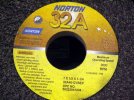You're not going to find any surface grinders that run belts, that weren't converted by knifemakers.
Industry doesn't convert them for a reason, it mitigates the primary advantage of a surface grinder, making things flat and parallel. It's not a popular opinion, but as someone who owns 4 surface grinders, 2 of which are converted to belts, and operates a SG for many hours a day, I will encourage you to learn the capabilities of a good SG with a stone before ever considering a belt conversion.
I can get a better than 400 grit belt finish, that will indicate to orders of magnitude more flat and parallel, with a 50 grit stone dressed properly, and ground properly, on a tight SG, than any belt converted grinder can achieve. The *ONLY* advantage a belt conversion has, is in hogging material at a high rate, although it's a stop gap to more efficient methods, such as face or slab milling, or blanchard grinding.
I use my belt converted large SG's that run 12 and 14" stones with hydro feeds, for one thing only, hogging damascus billets down to desired thickness. I don't have room at the moment for a large blanchard, although the moment I do, you can bet those grinders will be back to running stones exclusively.
The issue most have with SG's is either crap machines, or an unwillingness to learn to select stones, dress, and grind properly. I can't tell you how many times I've been complemented on a grinder finish for some blanks I've had laying around, by mastersmiths, asking how I got it. I just smile and say "with a stone".
Make sure the machine runs butter smooth, and that when you put your hand on the spindle, behind the wheel guard, that you feel no vibration, or hear any erratic noise. Of course, there will be some motor sound, and hydraulic feed machines can have quite a lot of hydrualic whine, but that's not an issue.
If all looks good, have the owner make a cut with a freshly dressed stone, and see that you don't get a choppy or wobbly finish, if so, you're gold.
In fairness, cheap unbalanced stones can cause the spindle or whole machine to vibrate. On smaller machines though, usually, norton stones can be run without balancing. I've never found one under 10" that needed to be balanced personally, but it's always a consideration. I do 90% of my work with the same stone, dress gently with a very small feed for a fine finish, dress quickly with a heavy feed for a more aggressive, quicker cutting finish.
Finish cuts on hardened steel are in the 0.0005 range, although you can hog (a few thou) much more with an aggressive wheel on thicker pieces you're going to finish in a second op. On the flip, with a ceramic belt on a contact wheel setup, you can feed 10-20 thou and walk away, compressing the wheel, as long as your machine can handle the load, and it'll keep cutting as the wheel expands, but the accuracy is relative.
I think most people with belt converted SG's assume they're getting much better accuracy than they are, which they'd realize quickly if they ever actually indicated the part for such.


